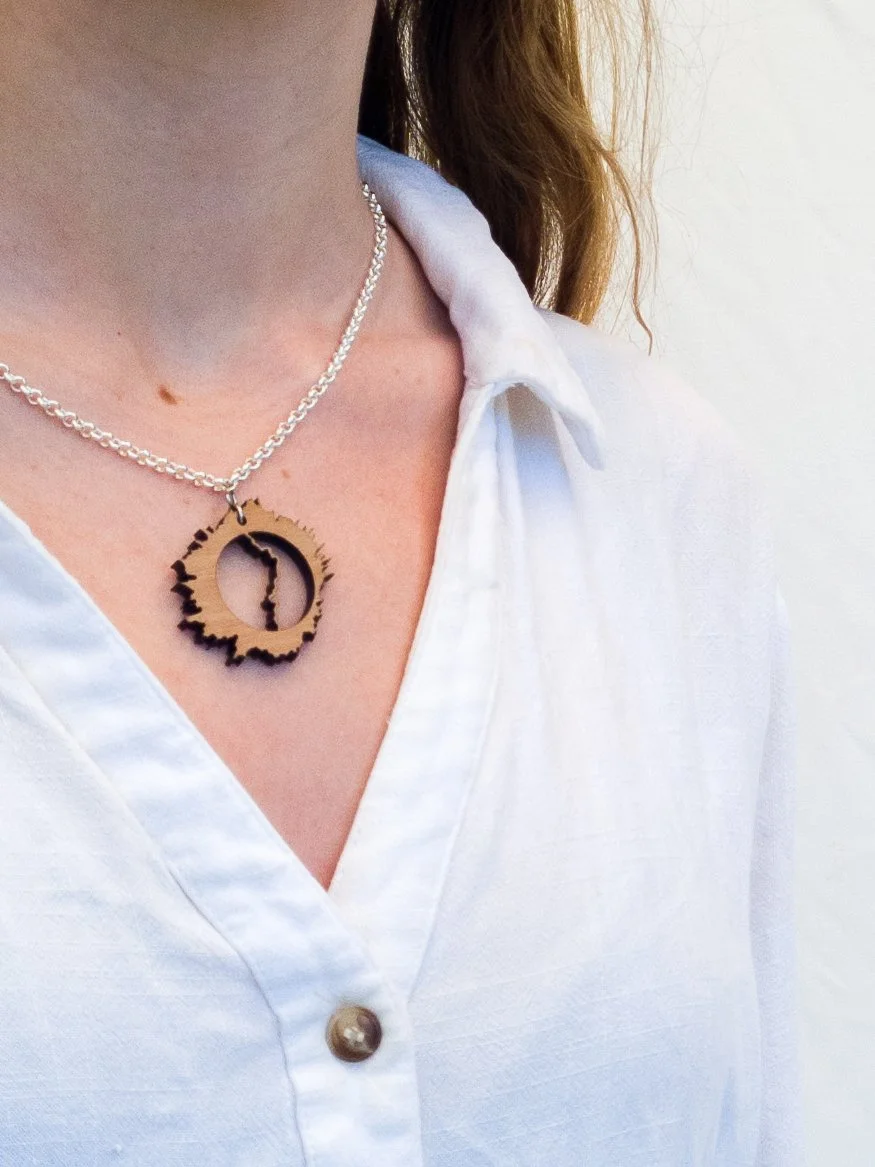Geo-Jewellery
Jordan McDonald, Beth O’Sullivan, Zoe Cuthbert
2021
Design - Laser cut MDF plywood, code
The concept for this generative and dynamic design and data visualization wearables came from a goal to create meaningful wearables that created a bridge between wearer, memory and landscape. We aimed to turn memories, experiences and achievements into tangible objects through customised jewellery. We create pendants that are authentic, unique and meaningful and align with sustainable and responsible jewellery practices at all levels of the production chain.
Early Development
The first concept plots the route of GPS data as negative space throughout the square. The idea was inspired by mazes and the concept that the route is the only way to navigate the maze. The area around the route was to be filled with an interconnected pattern created by code that was yet to be defined. Whilst we liked the concepts behind this idea, it was impractical as we were unsure how to code it and it produced lots of small parts that would be hard to cut out without compromising the pendants integrity.
Further Concepts
The final design we choose was a modification of our last concept. It uses the two data points of GPS route and elevation to create a representation of a journey. For ease of production, we choose to exclude any sort of filling pattern and to smooth the outside elevation lines so there were no sharp edges that could snap off or hurt the user.
The final design is a minimal piece that tells the story of a journey taken. The elevation and route create unique organic forms full of personality. By containing them within the circle, they are able to maintain form to create an elegant and pure piece of jewelry.
Web Portal
The code portion of the project involved reading GPX files (such as those exported by popular running apps like Strava). The web portal allows for users to upload their own files, and showcases a mockup image generated from the elevation and coordinates of the running track.
Post Processing
Post design production was done in Adobe Illustrator after the creation of the drawn GPX design. The first step was to join all the disconnected lines, as a GPS route consists of small lines joining each point and the laser cutting required unbroken lines.
The inner line was then thickened and expanded into a shape. Any final adjustments to the shape is made, such as removing sharp points and ensuring there is at least 1 mm of space between the outer edge and the internal cut edges. Finally, a 2.5-3.5mm hole is placed at the top of the design (or the next suitable position) to allow the pendant to be worn as a pendant. The design is then sent to the laser cutter as an SVG file.
physical prototypes
As sustainability and responsibility for the environment are at the core of our design ethos, we thoroughly investigated materials that would be suitable for our product. We have tried to consider the entire lifecycle of our product from the production to the materials, to disassembling and disposal. The jewelry industry as a whole is incredibly wasteful. It is filled with products that are mass prosecuted, designed poorly, and utilize unstainable and sometimes unsafe materials. We kept this in mind when trying to come up with a suit of material that we could use for our designs, as well as preparing the design for the future by creating a circular economy.
Originally we wanted our design to be made from metal. Thus we investigated what metals could be recycled, and if we could use recycled metals. We found that recycled gold and silver and stainless steel were recyclable; however, all three had a limit to the number of times it could be melted down and take a new form due to the breakdown of the metals structural integrity. This puts limits on the design’s circular economy lifecycle. Aluminium can be recycled infinitely and take many forms, without losing it’s structural integrity. Thus we decided that the ebay option was to look for laser cutting places that supplied aluminum sheets.
Unfortunately, we found that laser cutting metal was expensive and out of budget, so we investigated other laser cutting places. Most laser cutting places allow for the cutting of acrylic material or plywoods, however we found online laser cutting to have 4mm thick sustainably grown Australian wood. We thought that the Australian wood connected really well to our ethos and brand identity, connecting people and nature in Canberra and surrounds. Additionally we chose to go with spotted gum, which is endemic to the Australian South east coast, and found in Canberra, therefore drawing a stronger connection between human, product, experience and the landscape.















